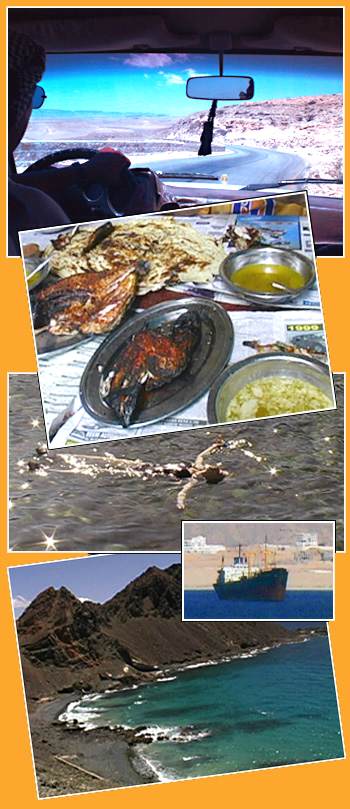
©ViewZone Expedition 2001

|
Ships laden with Far Eastern treasures once pulled their wooden bellies up to the docks of Al Mukalla.
Today, this bustling port city is the modern capital of Hadrhamout, an Eastern state in Yemen. Our expert driver, Abdul, navigated through the narrow streets which were filled with a rainbow of colorful fruit stands and fresh baked goods. Alighting from the Toyota at the beautiful Hadramout Hotel, there was a balmy scent in the air -- the Arabian Sea! Nasser revealed his hidden talent for picking the perfect fish at the open air restaurants. He ordered a delicious meal. Pan seared fish, chicken soup with yogurt, flat crispy bread, and fizzy drinks made for a fantastic lunch. It was all served on a newspaper table cloth [see left]. The eatery was popular and, since this was lunch, it was also very busy. We enjoyed the smells of the kitchen and the heady spices as we watched the boisterous and colorful people going by.
The lively restaurants and a kaleidoscope of shops were all found along the main street of the city, which hugged the rugged, rocky shoreline.
Al Mukalla had her back to the desert and her face is to the ocean. This port town was once reached almost exclusively by the sea. With the historic dependence on ships, cargo and things nautical, it was no surprise to see that the people of Al Mukalla and others all along the coast had remained so closely entwined with the ocean and her bounty.
After a fine meal we all returned to the Hadrhamout Hotel. The salt water was calling for me to come and play in the waves. Gladly!
|
|
Floating [see above] in the gentle waters of the Arabian sea, the bone-dry desert behind me seemed a distant dream. The water was quite salty and I remained afloat with little effort. Opening my eyes beneath the waves, I could clearly see the bottom as I chased tiny neon blue fish. Later, I collected the obligatory sea shells on the shore. There were lots of scalloped shells and bones, including some pretty big fish heads. Giant ships [see above] bound for the open sea moved patiently and smoothly through the bay, like the minute hand of a watch. I sat on the shore and watched the boats for a while, enjoying the quiet sound of the waves against the shore. After many hours in Abdul's Toyota, sitting still was a treat. The jagged volcanic rocks, sliding down to aqua blue water [see above], made for a dramatic and colorful vista. I was careful not to stand too close to the cliff's edge; it didn't look too solid! But the pictures were worth it.
|

Hosn al Ghuazi, as it is known today, was perched atop a lava cliff and serves as an unusual landmark that is pictured on Yemeni currency and in every tour book about this region.
It was easy to ignore the vehicles and highway and imagine these two structures flanking the wide gates to the ancient port. Camels would have been fed, caravans loaded from arriving ships, and a variety of supplies would have be traded in suqs on both sides of this once important gateway.
Caravan traders would head north from these gates to Hadhramout, but our crew was heading West to Bir Ali, along the coast of the Arabian Sea. A remote volcanic lake was said to be located along our route. Would we be lucky enough to find it? Camera in hand and sandals on my feet; I was ready to go exploring!
 |
Previous Page || ViewZone || --next-->